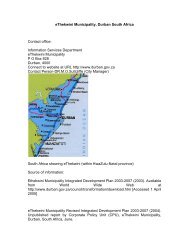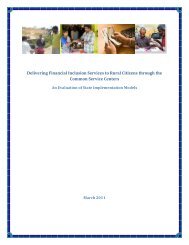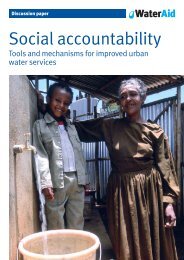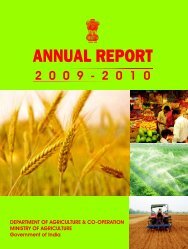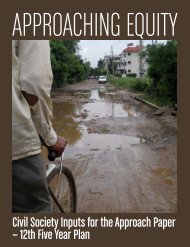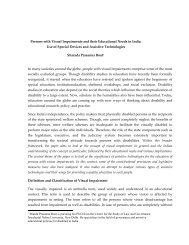Changing Framework of Local Governance and - Create
Changing Framework of Local Governance and - Create
Changing Framework of Local Governance and - Create
Create successful ePaper yourself
Turn your PDF publications into a flip-book with our unique Google optimized e-Paper software.
<strong>Changing</strong> <strong>Framework</strong> <strong>of</strong> <strong>Local</strong> <strong>Governance</strong> <strong>and</strong> Community Participation in Elementary Educationcreated through executive orders from the state have never taken roots <strong>and</strong> there is an absence<strong>of</strong> acceptance among stakeholders. It is important to work towards convergence between thestate <strong>and</strong> that <strong>of</strong> the grassroots level stakeholders. In recent years, some initiatives have beentaken in different states towards this <strong>and</strong> a few examples can be cited here. These states havetaken up different kinds <strong>of</strong> programmes according to their requirements <strong>and</strong> also have madeadministrative arrangements to implement these programmes not only for elementaryeducation but also for the children <strong>of</strong> pre-school level that could improve attendance <strong>of</strong>children in school at the later stage.Uttaranchal (a new hilly state which was earlier part <strong>of</strong> Uttar Pradesh) has opened Balvadis toprovide quality ECCE programme to 3-6 years old children. This programme was initiated intwo villages in 1998 <strong>and</strong> has exp<strong>and</strong>ed to 321 villages. The community owns each centre <strong>and</strong>provides a room for the centre while the members <strong>of</strong> the women’s group maintain the centre.Bal mela (Children’s fair) is also organized by a local NGO, the centre <strong>and</strong> communitytogether.The involvement <strong>of</strong> local organizations for ECCE is also evident in other states. In Bihar,Early Childhood Education centres (ECE) under DPEP are established by mata samitis(mothers’ committee) while in Gujarat, the Mahila Samakhya programme provides leadershipin running the early childhood programme in the villages where it emerged as a felt needamong the women <strong>of</strong> the Sanghas (Women’s collectives).Under DPEP, many states have adopted different models to provide ECCE. Some states likeUttar Pradesh <strong>and</strong> Gujarat set up ECE centres to address the problem <strong>of</strong> non enrolment <strong>of</strong>children due to sibling care. In Uttar Pradesh, the state government passed an order such thatwherever possible, primary schools would provide space for Anganwari Centres 32 (AWCs) intheir campus. In Assam, pre-primary classes were opened in the primary school precincts.These initiatives invariably involved the local community in the management <strong>of</strong> these centresthrough mothers’ groups, VECs <strong>and</strong> other local organizations. While a separate resource groupfor providing support to ECCE programme was formed in many states, the involvement <strong>of</strong>Cluster Resource Centres (CRC) <strong>and</strong> Block Resource Centres (BRC) was also consideredimportant to provide academic support to the instructors <strong>of</strong> these ECCE centres. A strongemphasis has been placed on school readiness programmes through these centres, theestablishment <strong>of</strong> linkages between primary schools <strong>and</strong> AWC/ECE centres <strong>and</strong> makingchildren familiar with the school. These are seen as important to improve enrolment <strong>and</strong>retention in primary schools. The Government <strong>of</strong> Andhra Pradesh has given high priority topreschool education to reduce the problem <strong>of</strong> high enrolments <strong>of</strong> under age children in class I<strong>and</strong> also to relieve older children from the responsibility <strong>of</strong> sibling care that prevents themfrom attending school.A similar emphasis on the involvement <strong>of</strong> the local community has been given for schooleducation. A Report by the Government <strong>of</strong> Madhya Pradesh points out that a series <strong>of</strong>mobilization activities such as Mahila Siksha Abhiyan 33 , have lead to a considerable increase32 Anganwari centres are run by the Department <strong>of</strong> Women <strong>and</strong> Child Development to implement IntegratedChild Development Scheme in selected areas. These centres provide necessary services to children <strong>of</strong> 0-6 years,pregnant <strong>and</strong> lactating mothers for fulfilling their nutritional <strong>and</strong> supplementary nutritional needs monitor thegrowth <strong>of</strong> children <strong>and</strong> also provide preschool education. Under DPEP <strong>and</strong> SSA these centres are also linkedwith Early Childhood Care <strong>and</strong> Education (ECCE) programme in convergence with the State EducationDepartment.33 Focused on enrolment <strong>of</strong> around 1.4 million girls particularly from SC / ST communities.29




